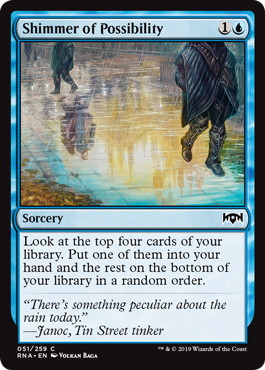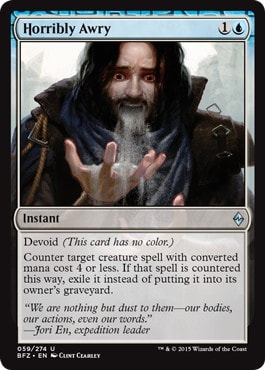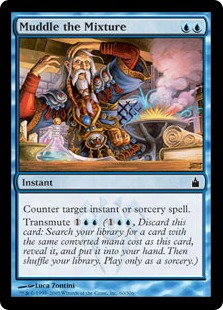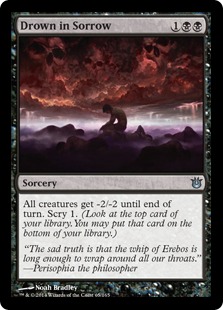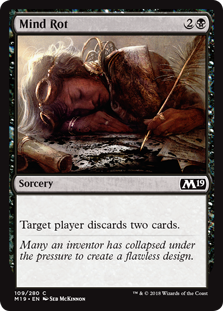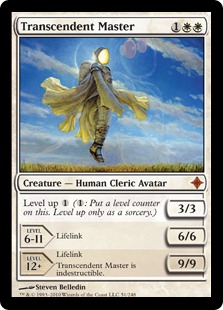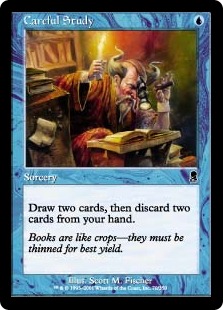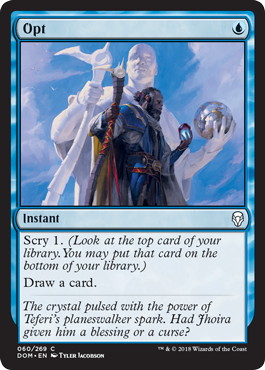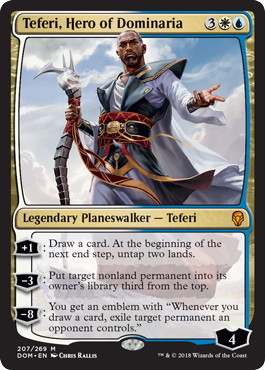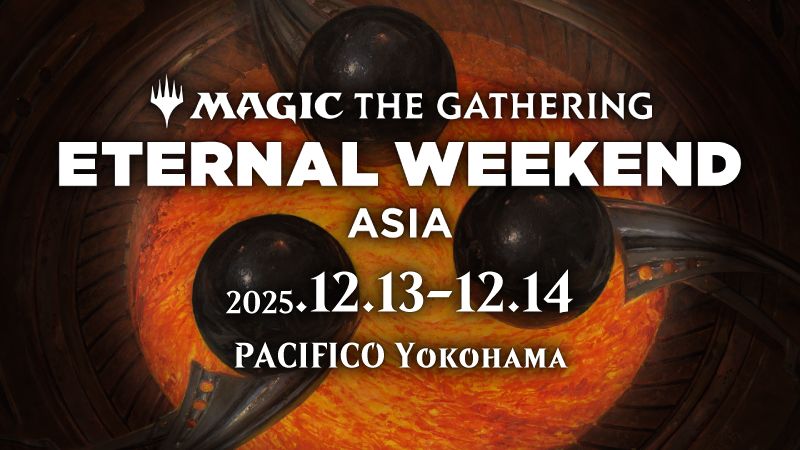Introduction
If I had to choose which area of my game has most improved over the past year or two, it would definitely be preparing for tournaments and using my time more effectively. Once I noticed some recurring patterns in my own testing process that hindered my performance at tournaments, I also noticed that many other players seemed to be making those same mistakes.
But before I go any further on what you should and shouldn’t be doing, I’m going to tell you a story of how I used to prepare for tournaments. A story of how a lot of players still do it. It actually bears a strong resemblance to the testing process of one of my friends for the most recent Mythic Championship in London.
So let’s begin……
The Conventional Adjustment Method
30 DAYS BEFORE THE TOURNAMENT

The Important Tournament is coming up, and I’m feeling good. This time, unlike many other times in the past, I’m going to practice well for it. There’s still plenty of time to find the mythical Best Deck, and hopefully even the Best Version of it. Our team just needs to test all the different decks and find out which one has the best expected win rate against the metagame.
I start by playing some leagues on Magic Online with the level 1 decks of the format. They seem like solid, normal decks, but nothing special. Most people already know how to play against those decks and are prepared with sideboard plans for those matchups. Some of those plans are, uh, “creative”, and not necessarily the most effective ones. Nonetheless, everybody has one so you’re not catching anyone off guard. They’re trying to beat your deck and by the end of the week, it seems like their plans are working.
21 DAYS BEFORE THE TOURNAMENT
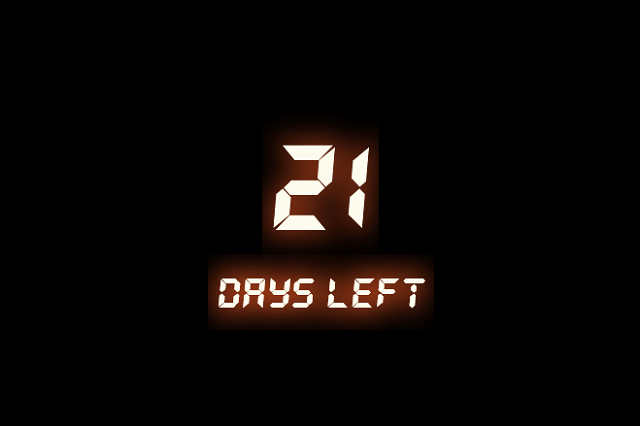
I’ve been talking with a teammate who says they have had really good results with a new homebrew deck. I’m intrigued and hopeful. Honestly, the deck looks a bit gimmicky and plays some funky cards that I don’t like, but the core seems like it should line up well against the most popular decks. I decide to give the deck a try and play some leagues with it.
The deck is definitely fun to play, and the core of the deck does indeed line up well against the most common archetypes. The problem is that the cards surrounding the core aren’t very good. When you draw your best cards the deck feels amazing, but when you draw more of the flex slots than the core cards, the deck feels like it’s lacking. It’s like playing Mono Blue Tempo in Standard when you don’t draw any 《Curious Obsession》 or 《Tempest Djinn》.
The Cool Deck has potential though, and maybe there are better options for the flex slots that we just haven’t found yet. Maybe the deck is a diamond in the rough, and with the careful tuning, we might be able to fix some of the problems. In the back of our minds, we can already see the deck tech videos, the Twitter posts, the top 8 profiles and the trophy shots. We just need to find the missing pieces to make the deck work, and then we’ll be famous deck builders who date swimsuit models, drive Ferraris and play with foiled out Legacy decks.
14 DAYS BEFORE THE TOURNAMENT
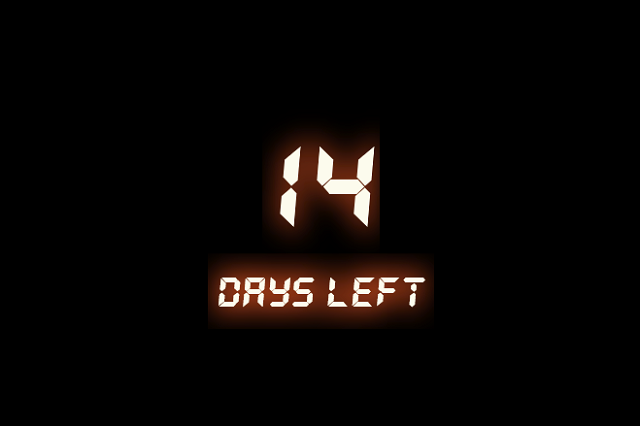
I check out the results from a midsized tournament in the US. The winner played a Classic Midrange deck. It looks boring and unimaginative as if someone had just scoured through their trade binder and picked up all the most expensive rares and mythics in those colors, with the only exceptions being some cheap uncommon removal spells and 4 《Duress》 in the sideboard to “fix” the control matchup. Even though the deck doesn’t excite me in any way, I have been working on the Cool Deck so much lately that I need a change of pace for just a league or two.
I had almost forgotten how nice it is to have a game against everyone, and how easy winning can be when you just cast high quality cards one after another, even if they don’t have any particular synergies. After a couple leagues of playing Classic Midrange, I try to go back to playing the Cool Deck. After a dozen matches, I slowly start to realize the truth that I had tried so hard not to see.
Despite our efforts, The Cool Deck would never be good enough. It’s inconsistent, the cards aren’t powerful on their own, the old decks-to-beat have become more streamlined and resilient, there aren’t enough sideboard slots to cover all the bases, and there are a couple of new decks that attack it from an angle that it can’t reasonably interact with. The metagame has moved on.
I play a bit more with Classic Midrange. It’s the textbook 50-50 deck. Always an okay choice, but never a great one, and requires an unrealistically accurate metagame prediction to be a good one.
7 DAYS BEFORE THE TOURNAMENT
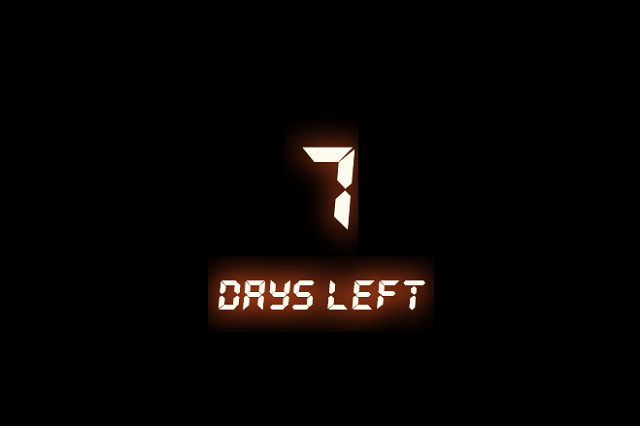
A Grand Prix has been held in Japan during the previous weekend. This time the winning deck has some crazy card choices that defy all the rules of traditional western deckbuilding. I love it! I immediately buy the missing cards on Magic Online and go play a few leagues, finishing 4-1, 5-0 and 4-1.
The deck feels smooth and well positioned in the metagame. I’m not sure how I should be sideboarding in certain matchups, and some of the numbers seem a bit off, but those problems are easy to fix.
After a productive day of testing, I’m finally feeling good about my chances in the Important Tournament. Before going to sleep I quickly check Twitter and this catches my eye:
the part of pt testing where we try to find that small sample heater to cling to is my favorite
— Paul Rietzl (@paulrietzl) 2019年2月17日
Small sample heater? Pfft. The Japanese Deck is just really good and the 87% win rate seems perfectly sustainable. Sure, one of my teammates went 2-3 and 1-3 with it, but that’s probably because they’re not as good at playing the deck, right? …right?
4 DAYS BEFORE THE TOURNAMENT

Wrong. Despite the positive first impression, it turns out that even the Japanese Deck isn’t perfect. In the next couple leagues, I crash and burn, going 2-3 and 1-3 just like my teammate. After a couple days of practice, the opponents have learned how they should be playing against the deck. It also turns out that even this deck doesn’t have protection from mana screw, flood or mulligans to 5. While it has a good matchup against last week’s most popular deck, it’s pretty bad against some others.
We have a chat session with the team. Despite testing a lot with the different decks, we have no idea who is actually favored in about half of the matchups in the metagame. Someone thinks the Japanese Deck is favored against Classic Midrange, and someone else thinks the opposite. There are reasonable arguments on both sides, and play patterns that seem common to one of them have never come up in the other one’s games. Generalizing from small sample sizes is much harder in practice than in theory.
There are a couple of decks that we could all agree on being bad, so at least we can safely cross out those from the list. But there’s still a bunch of options, none of which I feel comfortable with. I have no idea what I should do. I fire up some leagues with different decks, changing to a new one after each 2-3 or 1-3 result.
1 DAY BEFORE THE TOURNAMENT
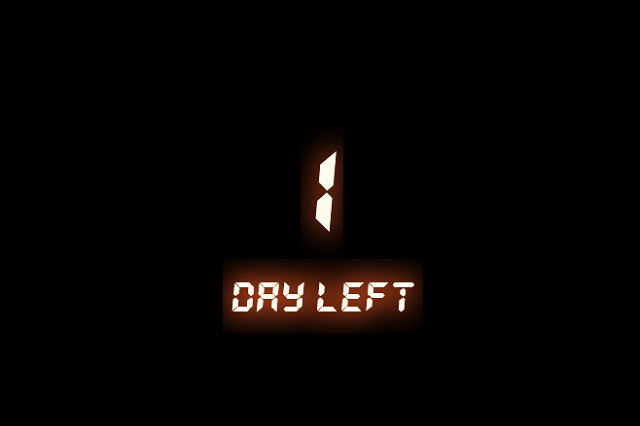
I feel like crap. None of the decks feel good, and after playing a few leagues with each of them I don’t really have enough experience with any of them. We have another meeting with the team and we conclude that Traditional Control might be the best positioned deck, but it’s also quite hard to play and it can often be too clunky against the aggressive decks. My other option is to just play Classic Midrange, as it is the deck I have played the most and feel least uncomfortable with. It doesn’t really have any good matchups though.
I could get a sideboard guide for Traditional Control from one of the team members, but I haven’t practiced much with the deck myself so the moment something unexpected or complicated happens, I’m screwed. I know I would mess up the mulligan decisions and would probably get outplayed in the mirror matches by more experienced pilots.
At this point it doesn’t really matter which deck I choose, I’m in trouble regardless. All I can choose is whether I would rather lose to play mistakes, bad matchups or both.
So where did it all go wrong?
The Cost of Indecision
I once encountered a quote by Sylvia Plath, from her novel The Bell Jar:
Cited from The Bell Jar
I saw my life branching out before me like the green fig tree in the story. From the tip of every branch, like a fat purple fig, a wonderful future beckoned and winked.
One fig was a husband and a happy home and children, and another fig was a famous poet and another fig was a brilliant professor, and another fig was Ee Gee, the amazing editor, and another fig was Europe and Africa and South America, and another fig was Constantin and Socrates and Attila and a pack of other lovers with queer names and offbeat professions, and another fig was an Olympic lady crew champion, and beyond and above these figs were many more figs I couldn’t quite make out.
I saw myself sitting in the crotch of this fig tree, starving to death, just because I couldn’t make up my mind which of the figs I would choose. I wanted each and every one of them, but choosing one meant losing all the rest, and, as I sat there, unable to decide, the figs began to wrinkle and go black, and, one by one, they plopped to the ground at my feet.
It should probably worry me that the moment I heard the quote, my mind instantly translated it to Magic terms, with the figs representing different deck choices.
So many times for so many tournaments, I have jumped from deck to deck, always trying to see if the grass is greener on the other side of the battlefield. It always ends the same way. One by one the decks start to wrinkle and go black, plopping to the trash can at my feet after the first league without prizes.
It’s not your Deck It’s How You Use It
Some time ago Mike Sigrist wrote an article called Play a Better Deck, in which he suggested that the best way to beat better opponents is to play a better deck. I believe this might be a great strategy for Mike himself, but not for most players out there. To be fair, I agree with some of the methods that are mentioned (especially innovating on old archetypes), but not on the general philosophy behind it.
I think the whole goal of trying to find the best possible deck for a tournament is misguided. If you have a team of full-time Pros, you might have enough resources to figure out good versions of all the decks and get enough data to determine how they fare against each other and then figure out which one of them is the best. But for most of us, that is simply an impossible task in such a short amount of time, and the sample sizes will always remain too small to draw any reliable conclusions from.
And what’s the treasure at the end of the rainbow anyway? Take the data from Mythic Championship London, for example:
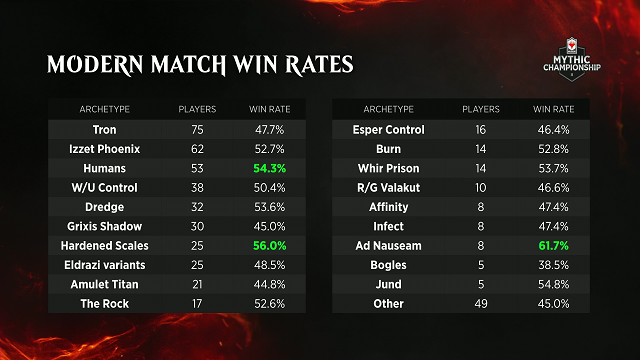
Image Copyright : MAGIC: THE GATHERING
The best performing decks with reasonable sample sizes are Humans and Hardened Scales, with 54% and 56% win rates respectively. If you compare this to the average win rate, 50%, you get a 4-6% gain by finding the best deck. Comparing the win rates to 50% is a bit generous though. You can usually quite safely exclude some of the worst decks, like Esper Control and the whole “Other” category. No offense to the Esper fans out there, but if you’re registering 《Esper Charm》 to a Modern tournament, you’re doing it wrong.
If you pick a random non-Other, non-Esper, non-Garbage deck, your average win rate is a bit over 50%, say 51-52%. Sure, sometimes it’s below 50%, but sometimes you also stumble onto the best decks by accident. The edge of the best decks over the almost random deck is 2-5%. That corresponds to about 1 match out of 20 or 50.
In contrast, what is the improvement in win rate that you get if you have had a lot of practice with your deck, know how to play it, are familiar with all of the most common matchups, know how to sideboard with it and have a great version? In my experience, it’s way more than 1 match out of 20 and way, WAY more than 1 match out of 50. THAT is the best way to improve your chances against a better opponent.
More games are decided by tight technical play than all other factors combined.
– Patrick Chapin
Even if you finally find out what the best deck is (which is a big if), by the time you do it’s usually too late to also get proficient with it. I have no doubt that a player like Sigrist can pick up any given deck on short notice and not lose too many percentage points, but for the vast majority, that’s not the case.
I also believe that having a well-tuned list of the deck you’re playing is a more significant advantage than finding the best deck anyway. Many matchups can turn from unpleasant to favorable by finding effective sideboard plans.
Even many of the pro teams that really tried to break the format didn’t end up playing Humans or Scales. So why would you try to reach for the unreliable 2-5%, when you could just pick a random deck you like and go for the bigger and more reliable gain in archetype proficiency?
So forget about the mythical Best Deck, and just try to find a Good Enough Deck that fits your playstyle and seems like one that you would enjoy playing with. Try to tune a great version of it and learn how to play it well. Try not to get discouraged too easily if your first leagues don’t go well unless it’s clear that it’s because the deck is bad and not because you just got unlucky or didn’t find the right lines.
After having a bad run with one deck and a heater with another deck it might seem like you made a great choice by switching, but in reality your chances of doing well at The Important Tournament will probably be better if you just stick to one deck. Variance is like a hustler on the street, painting pretty patterns with one hand while stealing percentage points off your win rate with the other. Just like with any other good hustler, you won’t realize you’ve been robbed until it’s too late.
Personally, as tournaments draw nearer, I try to narrow down my options to two different decks. If possible, it’s good to have two decks that are good in different matchups. That makes it easier to respond to shifts in the metagame. For the last week or two of practice, I focus solely on those two decks and try to find the best possible lists for each.
I’m in the fortunate position of having a part-time job and being a part-time student, so I have a very flexible schedule and have more time to play than, say, most GP competitors. If you have a full-time job, you need to narrow down your options even earlier. Different things work for different people, but for most players, I would recommend choosing your deck for GPs about two weeks and at the very least one week before the event.
Brewing Up New Decks
Playing decks of your own creation is one of the most fun parts of Magic, but it also carries some risks with it. I sometimes play homebrews as well, and in the GPs where I have played the Cool Decks, I have actually done better than when I have played stock decks.
For example, at GP Birmingham last year Leo Lahonen and I played our own unconventional version of Blue-White Control, and Leo made it all the way to the finals of that tournament. (Thanks to two-time national champion Mikko Airaksinen for the original list!)
Remember getting bored last year by the Blue-White lists that didn’t play any win conditions besides 《Teferi, Hero of Dominaria》 tucking itself indefinitely? I apologize. All of that was partially our fault.
If you want to try to build your own deck, you should keep a couple of things in mind. First, always have a solid backup option that you can turn to in the case that your brew doesn’t amount to anything. Most brews fail, and there isn’t enough time to optimize more than one or two of them, so the odds are simply against it. It’s easy to get carried away and spend too much time on the Cool Deck only to realize that it won’t be good enough and that it’s too late to master a backup deck.
Most people who work in the software industry or the start-up scene have probably heard the mantra “Fail Fast”, and it applies here as well. Reasons why decks ultimately fail tend to be the same ones time after time, so learning to spot them sooner rather than later lets you spend your precious time on more fruitful pursuits. Don’t be afraid to let go of the brews, no matter how sweet they are.
Conclusion
Until next time,
Matti



